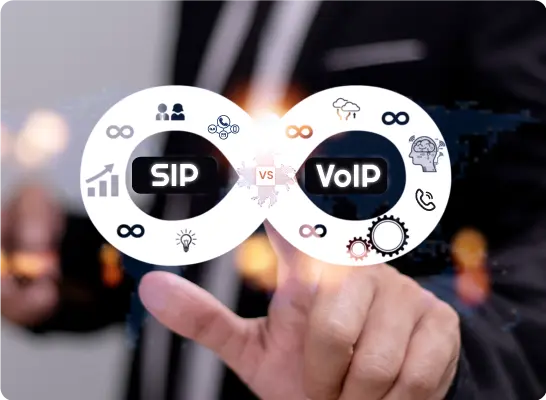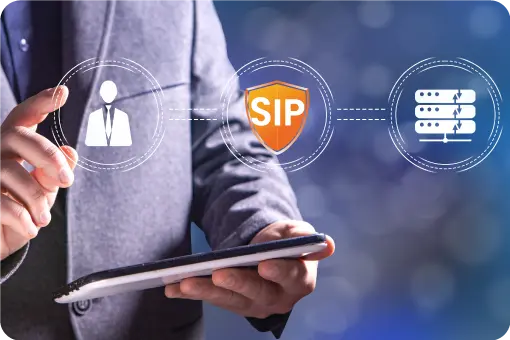Everything You Need to Know about SIP Trunking
- Session Initiation Protocol, or SIP, allows for the transmission of unified communications services over the internet. SIP trunking, then, is the combination of various SIP session branches, or channels. A different technology known as IP-enabled PBX (Private Branch eXchange), which is effectively a private phone network that expands on the phone-system functions that matter the most to businesses, allows for the truncation of several SIP sessions.
- SIP trunks operating on PBX networks are essentially virtual phone lines that let users place and receive calls to any anyone in the world with a phone number over the internet. SIP trunks make use of a packet switch network, in which voice calls are divided into digital packets and transmitted to their destination through a network. Prior to SIP becoming a well-liked and dependable way of sending voice signals, all calls were sent over the Public Switched Telephone Network (PSTN). The copper phone lines that we typically associate with the "telephone" are part of the PSTN network. Because the PSTN is a circuit-switched network, calls must be physically connected between two places in order to be completed.
- Contrarily, each SIP trunk accommodates several SIP channels (a SIP channel being equivalent to one incoming or outgoing call). No matter how many concurrent calls you anticipate, your company only requires one SIP trunk because a SIP trunk can contain an unlimited number of distinct channels. Depending on how many calls your firm will make at once, there may be a need for a certain number of channels.

VoIP, SIP, and Additional Associated Terms
To comprehend the fundamentals of SIP trunking, it is necessary to define a few key terminologies. Top SIP providers will offer solutions that allow you to reap the rewards without having a background in IT or telecommunications. However, to make the most of SIP technology, it is still quite beneficial to understand its fundamentals.
SIP vs. VoIP
SIP and VoIP are not the same thing, despite the frequent confusion. Voice over Internet Protocol is known as VoIP. This wide word includes a group of protocol technologies, SIP being just one, and it covers any phone conversation made over the internet. Therefore, it may be claimed that SIP, as one of its unique protocols, supports VoIP, yet not all VoIP is SIP.
Voice Codecs
To convert analogue frequencies into digital data or one digital format into another,
VoIP systems, including SIP, need codecs. To be transmitted over the internet, audio
voice signals are converted by codecs into compressed digital formats. The codec
transforms the signal into an uncompressed audio signal for replay when it gets to its
intended location on the network. VoIP is made feasible by it.
Varying codecs have different levels of compression. The two most used codecs for SIP
trunking are G.711 and G.729 G.711 gives uncompressed, high-quality voice, but G.729
uses compression to use less bandwidth at the price of sound quality.

Call Quality and Carrier Tiers
Any company communication system, especially those that are customer-facing, must have excellent audio quality. The best carrier solutions deliver voice quality that is nearly indistinguishable from that of conventional landlines, but it is crucial to pay close attention to the calibre of the carrier network that your SIP provider is using. Only Tier-1 carriers have direct access to the internet's backbone, ensuring the best call quality and dependability.

-
Tier-1 Carriers
Tier-1 carriers are sufficiently big to be independent of other network providers and don't need to pay them for using the network (technically, they employ "settlement-free peering" to operate). As a result, copper wires are to traditional PSTN landlines what Tier-1 infrastructure is to the internet. Similar to PSTNs, Tier-1 networks can offer a completely unrestricted worldwide network in addition to nationwide telephone coverage.
-
Tier-2 and Below
Instead, Tier-2 carriers must get the approval of Tier-1 carriers by paying for IP transit from them to have complete access to the internet. They must battle with numerous other peers of comparable size vying for network access, generating competition that frequently benefits Tier-1 carriers more than it does end consumers. As a result, businesses dependent on Tier-2 carriers are more susceptible to service changes and encounter worse reliability than businesses who deal directly with Tier-1 providers.
Businesses that have access to Tier-1 carriers should do so in order to ensure call quality and long-term dependability. There is no need to take a chance with Tier-2 providers who only tangentially connect their clients to the infrastructure that Tier-1 providers themselves control because the speed of business depends on the speed and reliability of their communications.
Quality of Service setting on the router (QoS)
A router setting called Quality of Service (QoS) instructs the network to give voice
calls priority over other data traffic. Users who are consuming data won't be affected
by slight signal reception delays or data loss, but voice calls might suffer greatly
from even the smallest latency delays, which can lead to serious communication failures.
When QoS is enabled, audio quality is guaranteed to be high even when other
data-intensive activities are going on.
For instance, any voice or video calls can be given priority access to bandwidth for the
duration of the conversation if your company is downloading or streaming huge files or
video content. Following the call, the priority bandwidth becomes available, allowing
the downloads to resume at a faster rate. Applying Quality-of-Service settings
effectively guarantees that the networking services that are most important to your
company always have access to the digital express lane when they are required.


Why Choose SIP?
For instance, any voice or video calls can be given priority access to bandwidth for the duration of the conversation if your company is downloading or streaming huge files or video content. Following the call, the priority bandwidth becomes available, allowing the downloads to resume at a faster rate. Applying Quality-of-Service settings effectively guarantees that the networking services that are most important to your company always have access to the digital express lane when they are required.
How Do I Pick the Best SIP Trunking Service?
The market for SIP services is highly active, and you may find a broad range of options
in the industry – meaning SIP trunking services suited to the needs of businesses are
not all created equal.
How, then, do you choose the best SIP trunking provider for your company? There are
several essential criteria:
How to Pick the Top SIP Trunking Service Provider
Now that you know the basics, you can choose the finest SIP trunking options for your
business. You don't need to be an expert in networking, IT, or telecommunications to
take advantage of SIP technology, but with the right SIP provider, your company may
expand as though you are.
Vitel Global is one option. If you directly connect your communications network to a
Tier-1 network, your enterprise-wide SIP channels will be even more dependable than the
landlines of old. It will also provide the redundancy, flexibility, and data security
you should expect when moving to expert SIP-trunking services, resulting in enhanced
productivity and business success for your organisation.
Join forces with Vitel Global to get going immediately. As your company's needs change,
you'll receive devoted, compassionate support to guide you through the implementation
process and moving forward.

Features of SIP Trunking
-
Interoperability
A trustworthy partner will provide platform interoperability, which allows them to tailor their services to your company communication needs rather than taking a predetermined strategy. A dependable SIP trunking system should be able to function in a wide range of digital contexts, just as the most durable apps and other software may be operated on any operating system.
Ask your head of IT which network systems your business relies on so you can ask potential SIP providers if their services are reliable with those systems to save time. Ask the same question of any system that you may have future plans to enhance. -
Live information
You should have access to as much real-time information as possible through your chosen SIP provider. Your sales, marketing, and customer service plans will be driven by this data, which will give you crucial performance measurements.
-
Data security
Data security is a top priority for a reliable SIP trunking supplier. Learn what security precautions they must take to guard against security problems including malware, toll fraud, and various hacking techniques in general. Make sure to ask them about their security procedures for both your business and their own.
Ask them to demonstrate where you may discover their written, binding policy about data sharing and privacy. Your trade secrets are important, and anything you post online could be the target of competitors or digital thieves, so SIP trunking providers must offer cutting-edge security measures, just as you would expect with any other form of digital asset protection. -
Internet service provider
selection
The best providers will let you select your own internet service provider, ensuring that SIP trunking services are accessible in as many places as feasible. Choice enables the primary advantages of flexibility and network cohesiveness, and using the internet service provider with whom you already have a positive relationship is crucial to ensure that your new SIP service meets your demands.
-
Flexibility
True SIP market leaders should offer direct configuration of their service for use with virtually any IP-PBX or softphone brand in addition to a low-cost alternative for switching to new SIP trunking services. If you've previously installed a SIP trunking system and found it to be working but now wish to update it, find out if your new potential SIP provider can make use of what is already in place.
Even if you are satisfied with your existing services, keep an eye out for the chance to upgrade, and be aware of any pressure to instead downgrade your present system. The ideal SIP service won't demand that you give any flexibility. -
Redundancy
Ask about redundancy capabilities to smoothly divert calls in the event of a network breakdown to ensure business continuity. This is a crucial advantage of SIP trunking, one whose significance is occasionally overlooked by many SIP providers. If your SIP provider doesn't fully utilise this capacity, you could be losing out on redundancy services that are comparable to having multiple hard-wired lines for a PSTN via SIP telephone networks.
-
Training
Check to see if the service provider you are thinking about offers thorough training for SIP trunking and associated technology. You should not settle for anything less, and professional training will go a long way to ensuring that your new investment operates at the maximum level right away.
-
Consumer Assistance
Your SIP trunking platform should give knowledgeable technical support for all issues, and it's crucial that your SIP provider is as accessible as (or even more so than) a landline provider would be. Your profitability will suffer until your communications infrastructure is operational again. The quality of your SIP Trunking provider's general professionalism and degree of knowledge will also be revealed by their superior customer service.
-
Carrier Troubleshooting
Any carrier-related problems that may arise will be helped by the top SIP trunking companies. One of the main advantages of using a Tier-1 SIP trunking service is that they will deal directly with the organisations in charge of the network itself. With the alternatives, you will be forced to rely on the quality of their connections with other businesses, which, even when they are strong, means dealing with more moving parts and unnecessarily increasing system complexity.
-
Automation
Discover the level of automation that your potential provider offers. Existing and how manageable are remote implementation, monitoring, and maintenance processes? Minimize the need for human interaction while remaining confident in your capacity to recognise early signs that the system should be simplified.
-
Pricing
Verify the SIP supplier's pricing structure to see if it is transparent and straightforward. Do they require a lengthy contract with additional onerous terms? Are there any upfront prices or ongoing fees? Top partners who also offer prepaid and no-contract services will be able to offer affordable monthly charges per unlimited SIP trunk channel. You should then be able to create, delete, or upgrade channels whenever you want using a simple web control panel.
-
Free Trial
Check to see if your provider offers a free trial before making a purchase so you may assess the service and first-hand experience the benefits of SIP trunking. To get your new SIP trunking system off to the best possible start, make sure your current networking hardware and software platforms are compatible (meaning it will work just as smoothly for your vendors and customers, as well).


